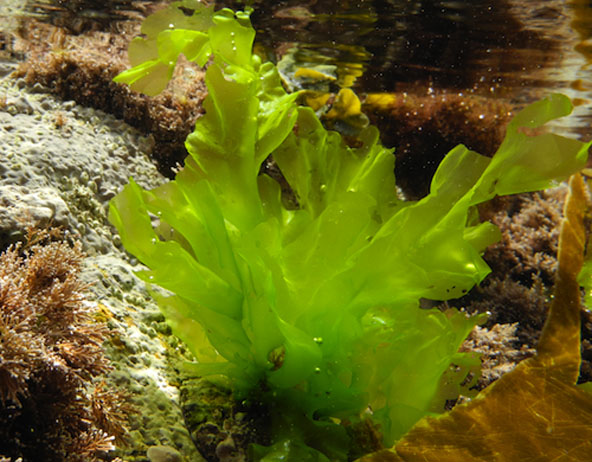
When faced with the human intestinal bacteria, most of these polysaccharides are not digested by humans, and hence, can be regarded as dietary fibers. Water-soluble and insoluble fibers have been associated with different biological activities and health-promoting effects. Soluble polysaccharides are primarily associated with hypocholesterolemic and hypoglycemic effects (Panlasigui et al., 2003). Furthermore, insoluble fibers, such as cellulose are associated with excretion of bile acids, increased fecal bulk, and reduced intestinal transit time (Burtin, 2003; Moore et al., 1998).
Among the polysaccharides isolated from the sea lettuces, ulvan has attracted greater attention as it displays several physicochemical and biological features. The name ulvan was actually derived from the terms ulvin and ulvacin, which refer to different fractions of Ulva lactuca water-soluble polycassarides. Presently, it is being used to refer to the polysaccharides from the members of the Ulvales, mainly sea lettuces.
Researchers have revealed that ulvan exhibits various biological activities, such as anticoagulant, antiviral, antioxidant, antiallergic, anticancer, anti-inflammatory, antihyperlipidemia, etc. For example, Qi et al. (2005) have prepared ulvans of different molecular weights from Ulva pertusa using sulfur trioxide/N,N-dimethyflormamide (SO3-DMF) in formamide, and their antioxidant activities investigated. The results showed that low molecular weight ulvans have a strong antioxidant activity. The rationale for this is that the low molecular weight of ulvan may incorporate into the cells more efficiently and donate protons effectively compared to the high-molecular weight one (Qi et al., 2005). Ulvan may also modulate lipid metabolism in rats and mice.
A decrease of serum high-density lipoprotein cholesterol (HDL-cholesterol) and an increase of low-density lipoprotein cholesterol (LDL-cholesterol) and triglyceride are considered to be significant risk factors in cardiovascular diseases. Ulvan or ulvan-derived oligosaccharides significantly lowered the level of serum total cholesterol, LDL-cholesterol, and reduced triglyceride, while they increased the levels of serum HDL-cholesterol (Pengzhan et al., 2003).
In addition, Mao et al. (2006) found that the anticoagulant activity of ulvan from Ulva conglobata mainly consisted of rhamnose, with variable contents of glucose and fucose, trace amounts of xylose, galactose, and mannose. Anticoagulant activity of ulvan has also been reported from U.Lactuca (AhdEl-Baky et al., 2009). In comparison, Ulva neumatoidea extracts have higher anticoagulant activity compared to other seaweed species, such as Egregia menziesii, Silvetia compressa, and Codium fragile (Guerra-Rivas et al., 2010).
These biological properties of ulvan open up a wide field of potential applications in food, pharmaceutical, agricultural, cosmetic, and chemical applications. Some of these potential applications are already the subject of patents.
We have this available on https://seatechbioproducts.com/sea-lettuce-ulva-sp-human-nutrition-powder-25kg.html
Marine Nutraceuticals Prospects and Perspectives- Edited by Se-Kwon Kim (Page 6-7)
Photo: https://propelsteps.wordpress.com/tag/weeds/